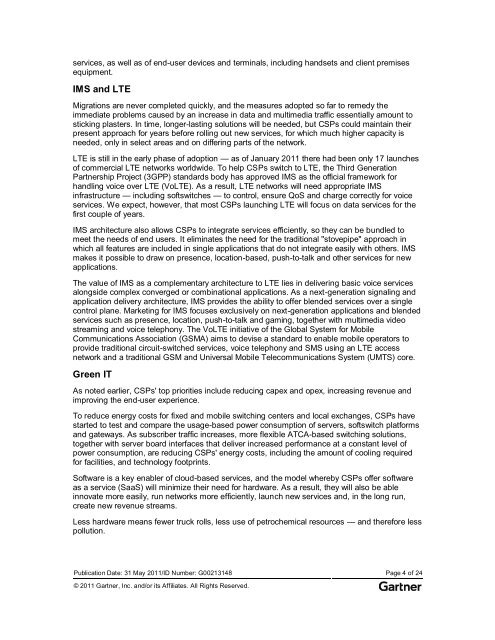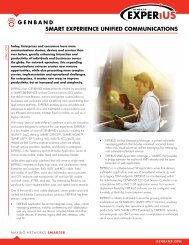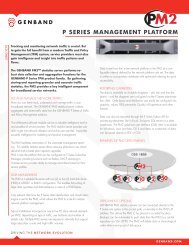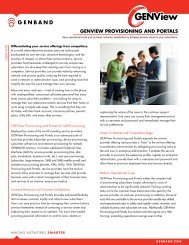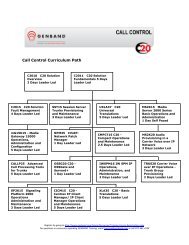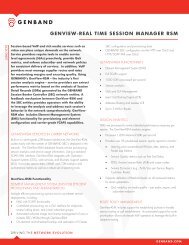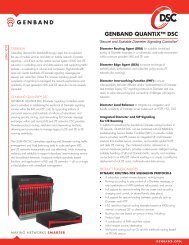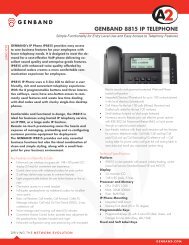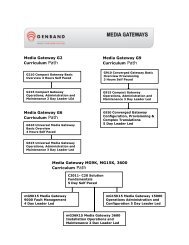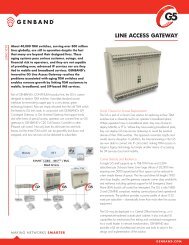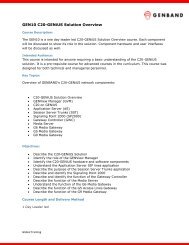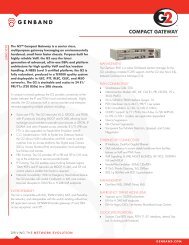Research Magic Quadrant for Softswitch Architecture - Genband
Research Magic Quadrant for Softswitch Architecture - Genband
Research Magic Quadrant for Softswitch Architecture - Genband
You also want an ePaper? Increase the reach of your titles
YUMPU automatically turns print PDFs into web optimized ePapers that Google loves.
services, as well as of end-user devices and terminals, including handsets and client premises<br />
equipment.<br />
IMS and LTE<br />
Migrations are never completed quickly, and the measures adopted so far to remedy the<br />
immediate problems caused by an increase in data and multimedia traffic essentially amount to<br />
sticking plasters. In time, longer-lasting solutions will be needed, but CSPs could maintain their<br />
present approach <strong>for</strong> years be<strong>for</strong>e rolling out new services, <strong>for</strong> which much higher capacity is<br />
needed, only in select areas and on differing parts of the network.<br />
LTE is still in the early phase of adoption — as of January 2011 there had been only 17 launches<br />
of commercial LTE networks worldwide. To help CSPs switch to LTE, the Third Generation<br />
Partnership Project (3GPP) standards body has approved IMS as the official framework <strong>for</strong><br />
handling voice over LTE (VoLTE). As a result, LTE networks will need appropriate IMS<br />
infrastructure — including softswitches — to control, ensure QoS and charge correctly <strong>for</strong> voice<br />
services. We expect, however, that most CSPs launching LTE will focus on data services <strong>for</strong> the<br />
first couple of years.<br />
IMS architecture also allows CSPs to integrate services efficiently, so they can be bundled to<br />
meet the needs of end users. It eliminates the need <strong>for</strong> the traditional "stovepipe" approach in<br />
which all features are included in single applications that do not integrate easily with others. IMS<br />
makes it possible to draw on presence, location-based, push-to-talk and other services <strong>for</strong> new<br />
applications.<br />
The value of IMS as a complementary architecture to LTE lies in delivering basic voice services<br />
alongside complex converged or combinational applications. As a next-generation signaling and<br />
application delivery architecture, IMS provides the ability to offer blended services over a single<br />
control plane. Marketing <strong>for</strong> IMS focuses exclusively on next-generation applications and blended<br />
services such as presence, location, push-to-talk and gaming, together with multimedia video<br />
streaming and voice telephony. The VoLTE initiative of the Global System <strong>for</strong> Mobile<br />
Communications Association (GSMA) aims to devise a standard to enable mobile operators to<br />
provide traditional circuit-switched services, voice telephony and SMS using an LTE access<br />
network and a traditional GSM and Universal Mobile Telecommunications System (UMTS) core.<br />
Green IT<br />
As noted earlier, CSPs' top priorities include reducing capex and opex, increasing revenue and<br />
improving the end-user experience.<br />
To reduce energy costs <strong>for</strong> fixed and mobile switching centers and local exchanges, CSPs have<br />
started to test and compare the usage-based power consumption of servers, softswitch plat<strong>for</strong>ms<br />
and gateways. As subscriber traffic increases, more flexible ATCA-based switching solutions,<br />
together with server board interfaces that deliver increased per<strong>for</strong>mance at a constant level of<br />
power consumption, are reducing CSPs' energy costs, including the amount of cooling required<br />
<strong>for</strong> facilities, and technology footprints.<br />
Software is a key enabler of cloud-based services, and the model whereby CSPs offer software<br />
as a service (SaaS) will minimize their need <strong>for</strong> hardware. As a result, they will also be able<br />
innovate more easily, run networks more efficiently, launch new services and, in the long run,<br />
create new revenue streams.<br />
Less hardware means fewer truck rolls, less use of petrochemical resources — and there<strong>for</strong>e less<br />
pollution.<br />
Publication Date: 31 May 2011/ID Number: G00213148 Page 4 of 24<br />
© 2011 Gartner, Inc. and/or its Affiliates. All Rights Reserved.


